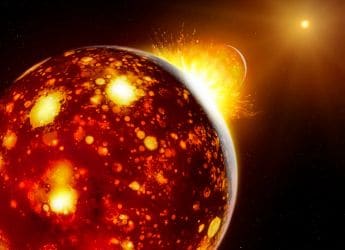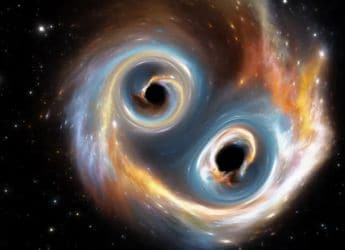- Home
- Science
- Science News
- Webb’s Stunning View of Apep Shows a Rare Triple Star System Wrapped in Spirals
Webb’s Stunning View of Apep Shows a Rare Triple-Star System Wrapped in Spirals
NASA’s James Webb Space Telescope captures Apep, a rare triple-star system where two Wolf–Rayet stars create vast spiral shells of carbon-rich dust.

Photo Credit: NASA
JWST captures Apep, a rare triple-star system whose Wolf-Rayet winds forge vast carbon-rich dust spirals
At the end of 2025, NASA's James Webb Space Telescope gave us an amazing look at Apep, a unique triple-star system that's pretty far away. It features a couple of huge, dying Wolf–Rayet stars alongside a supergiant, all circling each other in a complex dance surrounded by dusty spiral shells. The mid-infrared images from Webb highlight a swirling 'cosmic embryo' filled with carbon-rich dust. This work, led by Yinuo Han from Caltech and Ryan White from Macquarie University, provided one of the clearest views yet of colliding stellar winds.
A Unique Triple-Star System
According to NASA, Webb images show Apep contains two massive Wolf–Rayet stars and a more distant supergiant. The Wolf–Rayet stars orbit roughly every 190 years — far longer than usual for such binaries.
When the stars draw near, their strong winds collide to form thick clouds of carbon-rich dust. Over several centuries, these winds have generated four nested spiral shells visible in Webb's mid-infrared image. The distant third star carves a funnel-shaped hole through the dust as it orbits, revealing its presence even though all three stars merge to a point in telescope images.
Cosmic Dust and Future Stars
Wolf–Rayet stars are rare, massive stars nearing the end of their lives. In Apep, abundant carbon dust is produced by collisions between the pair's stellar winds; this dust stays warm and infrared-bright (thisis.caltech.edu).
Such winds throw the dust out in almost regular spiral shells that act like a "fossil record" of the stars' activity. Shells extend tens of trillions of kilometers, effectively seeding the Milky Way with carbon and other building blocks of future planets and stars.
Get your daily dose of tech news, reviews, and insights, in under 80 characters on Gadgets 360 Turbo. Connect with fellow tech lovers on our Forum. Follow us on X, Facebook, WhatsApp, Threads and Google News for instant updates. Catch all the action on our YouTube channel.
Related Stories
- Samsung Galaxy Unpacked 2025
- ChatGPT
- Redmi Note 14 Pro+
- iPhone 16
- Apple Vision Pro
- Oneplus 12
- OnePlus Nord CE 3 Lite 5G
- iPhone 13
- Xiaomi 14 Pro
- Oppo Find N3
- Tecno Spark Go (2023)
- Realme V30
- Best Phones Under 25000
- Samsung Galaxy S24 Series
- Cryptocurrency
- iQoo 12
- Samsung Galaxy S24 Ultra
- Giottus
- Samsung Galaxy Z Flip 5
- Apple 'Scary Fast'
- Housefull 5
- GoPro Hero 12 Black Review
- Invincible Season 2
- JioGlass
- HD Ready TV
- Laptop Under 50000
- Smartwatch Under 10000
- Latest Mobile Phones
- Compare Phones
- Lava Agni 4
- Wobble One
- OPPO Reno 15 Pro
- OPPO Reno 15
- Vivo Y500 Pro
- Realme GT 8 Pro Aston Martin F1 Limited Edition
- Huawei Mate 70 Air
- Moto G57
- Asus ProArt P16
- MacBook Pro 14-inch (M5, 2025)
- iQOO Pad 5e
- OPPO Pad 5
- Fastrack Revoltt FR2 Pro
- Fastrack Super
- Acerpure Nitro Z Series 100-inch QLED TV
- Samsung 43 Inch LED Ultra HD (4K) Smart TV (UA43UE81AFULXL)
- Asus ROG Ally
- Nintendo Switch Lite
- Haier 1.6 Ton 5 Star Inverter Split AC (HSU19G-MZAID5BN-INV)
- Haier 1.6 Ton 5 Star Inverter Split AC (HSU19G-MZAIM5BN-INV)

















